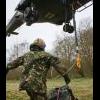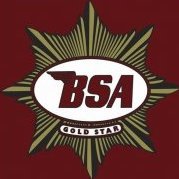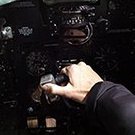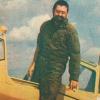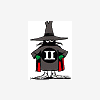Search the Community
Showing results for tags 'Hudson'.
-
I hadn't though of doing this as a WIP build - but have had a rethink: i) I had all sorts of trouble finding any build reviews of this one - and suspects there's quite a few of these in peoples stashes (either as Contrail, or the Sanger re-release). ii) hoping that actually building it will provide the impetus for an injection moulded 1/48 Hudson (Airfix?). That's invariably the way it works isn't it? Scalemates says this was originally released in 1984, then re-released by Sanger in 1992 in a new box. The Classic Airframes Hudson kit came out in 2000 - a significant step forward but almost impossible to come by this day (unless you're lucky at a Swap Meet or online 2nd hand). In frustration (at not being able to get a Classic Airframes kit) - I bit the bullet and picked this one up 2nd hand for not much at all. The original purchase price (in $AU) suggests that this wasn't a bargain basement kit at the time. Here's the back of the box. In the spirit of truth in advertising - note the warning: Not suitable for children, contains small metal parts, considerable modelling experience required. They aint kidding - as we'll find out shortly....
-
Maybe I'm just a glutten for punishment, but I'm starting a 1/48 Classic Airframes Lockheed Hudson III, to be finished as LM*L, 113(BR) Sqdn, RCAF, which scored the RCAF's first U-Boat kill. Right off the hop, I knew about the split elevator problem, instead of the correct one piece elevator. What I didn't know until now was that CA had molded ALL of the fight controls scalloped out as though they were fabric covered instead of the correct metal! Should be an interesting challenge! Aviaeology's excellent decals set "First kill Hudsons"
- 45 replies
-
- 6
-

-
- Hudson
- Classic Airframes
-
(and 1 more)
Tagged with:
-
My latest model finished the end of last week of a Lockheed Hudson I of P5143, 'VX-M' of 206 Sqn, Bircham Newton, May 1940. The Hudson was derived from the Lockheed Model 14 airliner to meet a RAF requirement for a General Reconnaissance (GR) aircraft or as a trainer. Buying a US aircraft for potentially operational duties caused a lot of comment at the time, as some believed the RAF should use only British aircraft. It was then decided,with the threat of war looming, to use the Hudson in its GR role as it offered better performance than the Avro Anson currently used. The Blackburn Botha was the intended replacement for the Anson, but was unlikely to be available in any numbers and when it did appear the Botha proved to be a disappointment, being underpowered and most ended up as trainers. The Hudson first entered service with 224 Sqn in May 1939. 206 Sqn first received Hudsons in March 1940 as replacements for Ansons although the latter lingered until June 1940. The model was built using the MPM kit that first appeared in the mid 1990's and has been reissued by Revell. My model is from the original release and was a resident of the Shelf of Doom for some time, partially because I became disenchanted with the kit at a time when life and work were quite stressful. The kit, even for a limited run kit of the period is not the easiest. Although MPM had moved on to injected moulded transparent parts by that time, it still relies on butt joints in places where some more locating points might have been helpful, like the nose. Fit of some of the parts was also quite vague and not helped by the instructions. The kit has quite a few alternative parts to cater for later marks and this does not help the fit. For me the major jarring note is the Boulton Paul turret, that looks no advance shapewise on the Airfix kit from the sixties.. Thanks to a conversation with Tony O'Toole of this parish at the Bolton Show, the turret has been replaced by a spare from the Revell Halifax III kit with a scratch built interior. Also from the Bolton Show I purchased some Deluxe materials 'Looks Like Glass'. not cheap, but you get a lot for your money and really does look shiny and clear. Paintwork is from the Mr Hobby Aqueous Colour range for the Dark Green and Dark Earth with Vallejo White Aluminium Metalcolor undersurfaces. The kit offers the decals for the aircraft modelled, but looking ata photo of the real aircraft, these were replaced with markings made up from various Modeldecal sheets. now it is finished I am fairly happy with it and can now give my full attention to the Group Build York. As the Marketing Department of the Sirius Cybernetic Corp. would say, 'Share and Enjoy'
- 15 replies
-
- 34
-

-

-
Good afternoon all, I’m working my way through a Classic Airframes Hudson and need some help with the turret. I’ve already given up with the one that comes with the kit and have pinched one from my Revell Ventura which is far better in profile. However, one thing they both have in common is the total lack of interior detail. Does anybody have any interior photos or diagrams they would be prepared to share? I’m aware there is a restored one at the Yorkshire Air Museum but a trip up there isn’t convenient at the moment. Best regards Howard
- 8 replies
-
- Hudson
- Classic Airframes
-
(and 1 more)
Tagged with:
-
I am painting a 1/72 Lockheed Hudson in the post late 1941 Coastal Command white undersides with extra dark sea grey topsides. I just wanted to check before I slap paint on. The wing and tail leading edges were painted a dark colour, was this black or was it another dark colour such as blue or green. https://images.app.goo.gl/PRRe59AqAyFS7S6S6
-
I have a bit of an enthusiasm at the moment for these twin - tailed, twin - engined planes from the Lockheed Co. They played a major role in taking the makers from the brink of collapse and closure right up to the top of the global plane - making industry. The more I find out about them, the more I like them. I've got a collection of kits to work on, and I don't think it's all going to be in one nonstop frenzy of plastic bashing. But there could be a fair bit of Lockheed ahead for me and my tube of glue. Here's what I've got, so far... (I know...!) And I got 2 of these boxes of joy... So, the idea is to put anything I do in this ongoing project on here, and thus keep it all in one place. I'm not visualising anything military with these, apart possibly from the 2nd Ventura, maybe... This sums up the vision I have of what I'm trying to achieve... Silver Birds! I've made a start on the Airfix Hudson kit (!) to be an L14, and I've been knocking 7 bells out of a PV1 to civilian-ise it without trying to make a fancy Howard 500 conversion. I took a few pictures on the way, and I'll get the progress so far on here as time permits. There's a Curtiss C46 on the bench right now, waiting patiently for progress and completion, and she's put up with quite a lot of me fooling around with the Lockheeds already!
- 179 replies
-
- 10
-

-
I’ve been following BritModeller for a while, but having seen a couple of Hudson WIP builds, I felt I had to contribute something of my own. This is my version of the Revell 1/72 Lockheed Hudson, which started life as a limited run by MPM, then was picked up by Italieri, before finding its final resting place in Revell’s back catalogue. I was lucky enough to find one in my local model shop in Saint Paul, MN. I chose to make P5120 of No. 206 Squadron, a Mk. I variant from 1940, based at Bircham Newton. The Hudson played an important role in coastal defenses during WWII. An American aircraft, it was adopted by the RAF after a series of hasty redesigns to meet their exacting specifications. Built in the US, one of the first shipments was dragged by mules over the Canadian border and put on a boat to Britain to be outfitted there as a patrol bomber. As reported by others, this kit is not an easy build. Its vintage engineering was a real challenge to my limited skills, requiring shimming, filling and sanding over numerous sessions. Despite this, seeing the iconic shape of the Hudson emerge over time was worth the effort. I wanted to depict it in flight, and as this was not a supplied option, I had to chop the wheels down to fit in the too shallow wheel wells. I added some detail to the cockpit and navigator's area - all completely invisible through those tiny windows! I also added a very nice pilot and navigator from PJ Productions, and used Montex Masks for roundels, windows and gun turret. To finish it off, I replaced the kit guns with Master .303 Browning barrels - tiny brass miracles. Not conventionally attractive, the Hudson’s bulbous silhouette nevertheless makes for a striking appearance. I remember my dad’s Airfix version, built in the 70’s and gathering dust for a couple of decades after. This build is a homage to that memory and all the pilots who mastered this bulldog of a plane.
- 24 replies
-
- 59
-

-

-
Have you ever seen the photo of anti-sub (TSS over White) camouflaged Hudson sporting small-dia "blue" SEAC roundels? There's a very basic profile of such a plane in RAFweb ad perhaps they are right, but I need a proof to follow on with my model. Correct me please where I'm wrong: 1. The small SEAC roundel (in dark and blue or "India white") was introduced in early 1943. 2. Two RAF Squadrons (namely No. 217 and 353) were using Hudsons in maritime role over the India/Burma area at least until June 1943 (October 1944 for transport duties) 3. In October 1942 the AMO A.1096/42 included the Hudson (along with Fortress, Liberator, Wellington and Whitley) within the "large anti-sub aircraft" group, that were to be camouflaged in TSS over White. 4. The same document mentioned Hudson also in "medium coastal aircraft" group (along with Blenheim, Beaufort, Beaufighter and Hampden) that were to be camouflaged in TSS over Sky or TSS over Night (Beaufort, Hampden and Hudson only) 5. Using (over certain geographical areas) Azure Blue instead of Sky has been allowed officially in DTD360 Issue 2 of November 1943 for ASR aircraft, but I have heard (remind me please) about such practice seen much earlier. What's funny the same scheme of TSS over Azure Blue was a recommended/compulsory scheme for transport aircraft overseas. 6. Thus No.217 Squadron Hudsons between January and June 1943 should sport TSS over White with small SEAC roundels 7. No.353 Squadron Hudsons between January and August 1943 should look the same as No.217's machines or (if "coastal patrol duties" aren't the same as "anti-submarine work") they could feature TSS over Sky (or over Night or over Azure) 8. Between November 1943 and October 1944 the No.353 Squadron Hudsons (transport duties now) should be camouflaged in TSS over Azure 9. Between August and November 1943 they could look either like #7 or #8 depending on fact, whether transport was this unit primary or secondary role. Anyhow - each opinion will be aprreciated and thoroughly analysed. Cheers Michael
-
One of the few (and perhaps best known) Hudson units operating over the MTO was Australian-manned No.459 Squadron. These Hudsons (Cyclone-engined Mk.III and Mk.IIIA as well as TwinWasp-engined Mk.V and Mk.VI) had RAF serials, of which some 80-90 are known. Last pictures of these a/c, taken in early 1944, show most of them in high-demarcation anti-submarine RAF Coastal Command scheme of Extra Dark Sea Grey and Dark Slate Grey (Temperate Sea scheme) over White. But in the web there are also photos from earlier period, showing the a/c in low-demarcation scheme. I would like to know your opinion, whether these planes wore Temperate Land Scheme (DG/DE over Sky), earlier Temperate Sea Scheme (EDSG/DSG over Sky), Transport Command scheme (EDSG/DSG over Azure) or Desert Scheme (DE/MS over Azure). Some of them feature more contrasted areas, some are less-contrasted, so.... The photos I mention depict: T9397 Mk.III http://www.adf-gallery.com.au/gallery/459-Hudson/P007594 and http://www.adf-gallery.com.au/gallery/459-Hudson/P990152 V8998 Mk.III http://www.adf-gallery.com.au/gallery/459-Hudson/P892238 AE510 Mk.III http://www.adf-gallery.com.au/gallery/459-Hudson/P027089 FH242 Mk.IIIA http://www.adf-gallery.com.au/gallery/459-Hudson/P027085 FH257 Mk.IIIA http://www.adf-gallery.com.au/gallery/459-Hudson/P007596 FH285 Mk.IIIA http://www.adf-gallery.com.au/gallery/459-Hudson/P027092 FH292 Mk.IIIA http://www.adf-gallery.com.au/gallery/459-Hudson/P027088 FH300 Mk.IIIA http://www.adf-gallery.com.au/gallery/459-Hudson/P016921 FH351 Mk.IIIA http://www.adf-gallery.com.au/gallery/459-Hudson/P027084 as well as the unidentified a/c featuring nose art http://www.adf-gallery.com.au/gallery/459-Hudson/P007597 As the "anti-sub" planes belong to the same batch FH227-FH459 it looks almost sure, that white undersurfaces and fuselage sides were introduced "in field" over the previous low-demarcation scheme. But this is only my opinion, however... Cheers Michael
-
I have the Italeri 1/72 Hudson Mk. IV/V (kit 1253). Can it be made into a Hudson Mk.I without TOO much hassle, or should I look for the Revell AG 1/72 Hudson Mk.I kit? I want to do the recce Hudson Mk.I shown in the Warpaint book, on page 3 (N7357). Of course, I still have to figure out which paint I can find here to match the Light Slate Grey finish mentioned. Larry
-

New Digital Decal Releases from Oldmodels Decals
Oldmodels Decals posted a topic in The Rumourmonger
New Digital releases Australian MRH90 1/72 and 1/144 Newly released in Digital range (previously only available as Inkjet) RNZAF Hudson NZ theatre 1942 1/48 and 1/72 RNZAF Hudson Fiji/Pacific 1942 1/48 and 1/72 RNZAF Catalinas 6 Sqn 1943-44 1/48, 1/72 and 1/144 RNZAF Catalinas 6 Sqn 1944-45 1/48, 1/72 and 1/144 RNZAF Catalinas 5 Sqn – 3 OTU 1944-45 1/48, 1/72 and 1/144 RNZAF Catalinas 5 Sqn Post WWII 1/48, 1/72 and 1/144 RNZAF NH90 in 1/144 As always these are available through my website www.oldmodelsdecals.com and through TradeMe (for NZ customers). Please note that the Australian MRH90 sets will only be available through the website or direct contact (see website for e-mail address). To find the Australian aircraft on my website see the page “Australian / other Non-NZ a/c” (two pages above “NEWS!”) John Oldmodels Decals -
Hi guys, welcome to my GB build... the Airfix Lockheed Hudson that cost £6.00. It was originally used to look at for my Vacform kit, but I have no need for it now so it can get built now.. I'm almost certain this will be my only build for the GB, but I may try and squeeze in the Airfix (new tool) Typhoon too. to be finished OOB in 206Sqn Coastal Command colours Box shot by Totallyrad.co.uk, on Flickr Box + sprues by Totallyrad.co.uk, on Flickr
- 15 replies
-
- 1
-

-
- Less than a tenner
- £10
-
(and 5 more)
Tagged with:
-
Hudson Mk. I/II Patrol Bomber 1:72 Revell With war looming in Europe, the British Purchasing Commission began a search for suitable aircraft and armaments to meet the growing requirements of the RAF. One such search was for a maritime patrol aircraft to augment and eventually replace the Avro Anson. The Lockheed Corporation proposed a militarised version of the Super Electra airliner. Compared to its civilian counterpart, the Hudson had more powerful engines, a pair of Browning machine guns in the nose and four more in a Boulton Paul turret located in the dorsal position. In service, the Hudson was considered something of a hot rod in comparison with the Anson. It was capable of a maximum speed of 246 mph and could climb at a rate of 1,200 feet per minute, almost double that of the Avro design. The Mk. I was capable of carrying 750lb of bombs or depth charges, rising to 1,000lbs of weapons in later marks. The Hudson achieved a range of feats during its service life. On 8 October 1939, a Hudson achieved the first aerial kill of the war for a UK-based aircraft. In August 1941 a Hudson of 269 Squadron attacked U-boat U-570, forcing it to surrender. By the end of the war, nearly 3,000 Hudsons had been completed, far in excess of the original BPC order for 200. Revell have a tradition of bringing us kits which were originally produced by other companies, and this kit continues that trend. This Hudson was originally tooled by MPM of the Czech Republic and has also been released by Italeri, so this is actually the third outing for these particular moulds. Nestled inside Revells familiar blue box are four sprues of grey plastic and a single sprue of clear plastic. Together they hold a total of 161 parts, which is pretty high for a kit of this size (although quite a lot of them are not used for the Mk.I/II). The moulds appear to be in good shape as there is little flash present and, as far as I can tell, there are no flaws in the plastic. Surface detailing is comprised of fine, engraved panel lines and the overall impression is quite favourable. As you might expect from a kit with a relatively high part count, the interior is quite detailed. The flight deck itself is made up of a floor, pilots seat, jump seat for the second pilot, control column and instrument panel. The sidewall-mounted pilots radio control boxes are provided as separate parts. Moving forwards, the bomb aimers position is well appointed with a seat and bomb sight, as is the navigators position with its folding table. Moving aft, the cockpit bulkhead is present and correct, as are the radio transmitters and receivers and the radio operators position. The interior is rounded off with the internal seat position for the gunner. The overall impression is very favourable indeed. If prizes were awarded for the amount of interior detail, then this kit would be in with a chance of a medal. It is quite well known that this kit can be a challenge to assemble. Unusually, Revell have acknowledged this in the instructions, advising the builder to insert a 1mm shim between the fuselage halves immediately in front of the windscreen. Im not sure Ive seen this in a set of instructions before, although others may know differently. The nose glazing is moulded in upper and lower halves with a separate nose tip, so take care not to get any glue on a noticeable place when fixing it all together. Although this kit has no locating pins, there is a stubby spar to help align the wings correctly and give them strength. The wings and tailplanes are fairly straightforward as the ailerons, elevators and flaps are all moulded in place, although the flap track rails are separate components. The undercarriage bays housed within the prominent cowlings are quite nicely detailed and there are separate parts for the bay roofs which must be fixed in place before the wing halves are joined. The undercarriage itself looks nicely detailed and the main gear legs have separately moulded side struts and torque links. The instructions advise the use of tweezers for these parts, so you have been warned! I would certainly recommend taking at this stage, lest you end up with a wonky aeroplane. The large Twin Wasp engines are simple, single piece mouldings, but they should look ok once in place behind the cowlings. The propellers look ok, and there is a choice of spinners depending on which of the decal options you wish to use. The rest of the build is concerned with the addition of the transparent parts and the remaining fine details. These include the radio aerial mast and DF loop fairing, the nose mounted .303 inch machine guns and the engine carburettor intakes. The transparent parts are reasonably thin and clear , but I given the nature of the kit, I would recommend test fitting them. The framework on these parts could be clearer though, so you may want to invest in some Eduard masks in order to ensure that your canopy frames are clear and crisp. Two options are provided on the decal sheet: Lockheed Hudson Mk. I No. 244 Squadron, Royal Air Force, Leuchars, August 1940; and Lockheed Hudson Mk. I P5120, No. 206 Squadron, Royal Air Force, Bircham Newton, June 1940. Both aircraft are finished in Dark Earth/Dark Green camouflage. Other modellers have raised some doubts about the recommendation of silver for the undersides though, so check your references carefully before applying paint. The decals are well printed but they look a little matt so if I were you Id watch out for silvering. Conclusion This is a neat, well-detailed model which looks very good on the sprue. It has an unenviable reputation as being a tough kit to build, but it can be turned into a stunner with a little effort. Whilst I would recommend this kit (not least because it is streets ahead of the ancient Airfix offering), I would advise anyone considering it to familiarise themselves with some of the build logs on Britmodeller in order to avoid any of the potential pitfalls that lay in wait. Revell model kits are available from all good toy and model retailers. For further information visit
- 1 reply
-
- 1
-

-
- Hudson
- MPM Hudson
-
(and 1 more)
Tagged with:
-
Pics and notes thanks to Trevor. These photos are of Lockheed Hudson mk.IIIA A16-199/G-BEOX. Formerly at the Strathallan collection in Scotland, it is the only example of the type in Europe and is currently on display in the RAF Museum in Hendon. As a reference source it is a classic example of the real thing not being accurate enough. Last operated by Ad Astra Airways in Australia, in essence it is a post-war, modified and civilianised machine dressed up in military markings and has several non-standard features. From the nose they are: - Gloss paint scheme - None standard nose glazing - Modified cockpit glazing by the plating over of the dorsal glazing - No dorsal BoultonPaul turret - Bomb bay secured shut with fasteners - Ventral DF loop housing - Modified ventral gun housing. From the mk.III onwards there was a hatch (off set to starboard) housing one 0.303 machine gun. The housing on this example has been widened for other purposes (photography?) - As a mk.III, it should be powered by Wright Cyclones. This example was re-en gined with Pratt and Whitney Twin Wasps when operated by Ad Astra for common ality with the rest of its fleet. Even so the cowlings are non-standard in t hat the rear of the cowlings are flared. - The undercarriage legs are not sheathed.





